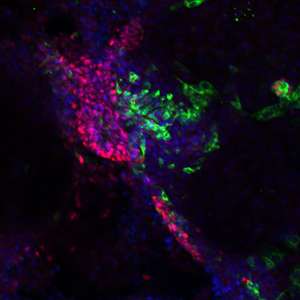A master gene determines whether cells become pancreatic or liver cells

A gene in human embryonic stem cells not only steers them to form a pancreas but simultaneously prevents them from becoming liver cells, A*STAR researchers have shown. This discovery is an important step toward growing functioning pancreatic beta cells in a dish, which may eventually help treat some forms of diabetes.
Ray Dunn first came across the 'pancreatic and duodenal homeobox 1' (Pdx1) gene as a PhD student in the USA. "There was a lab around the corner from me where they inactivated the Pdx1 gene and the resultant mice had this dramatic phenotype—they had no pancreas," he recalls.
"Of course the mice died rapidly because, without the pancreatic beta cells that make insulin, they couldn't regulate their blood glucose. It was really fascinating. How did inactivating one gene stop the organ from forming?"
Dunn, now at the A*STAR Institute of Medical Biology in Singapore, has been working with colleagues on the human analogue of the mouse gene Pdx1, PDX1, encouraging human embryonic stem cells to differentiate into pancreatic cells.
"As we were differentiating stem cells and trying to get them to become beta cells, we spent a lot of time working on the activation of PDX1—turning it on at the right time and in the right place," he says.
PDX1 was already known to be a 'master regulator' of pancreatic fate. Such regulatory genes produce proteins that bind to DNA in the nucleus of a cell and switch genes on or off. Dunn wanted to discover which genes the PDX1 protein was binding to.
Using a technique known as chromatin immunoprecipitation combined with DNA sequencing, Dunn's team determined exactly where PDX1 was sitting astride the DNA—and hence which genes it was regulating. It turned out that PDX1 was activating many genes that were needed to make a pancreas (see image).
The researchers were surprised to find that even though PDX1 is not expressed in the liver itself, it was found sitting on some liver genes in the DNA.
"So our simple hypothesis is that it is also acting as a repressor," says Dunn. "This is interesting from a developmental biology point of view because the liver and the pancreas develop from the same embryonic germ layer in close proximity to one another."
"PDX1 activates pancreatic genes and represses liver genes so it is helping the embryo to assign the right zip code for a particular organ," Dunn remarks. "This is the first time that PDX1 has been 'rebranded' as a repressor protein."
More information: "PDX1 binds and represses hepatic genes to ensure robust pancreatic commitment in differentiating human embryonic stem cells." Stem Cell Reports 4, 578–590 (2015). dx.doi.org/10.1016/j.stemcr.2015.02.015


















